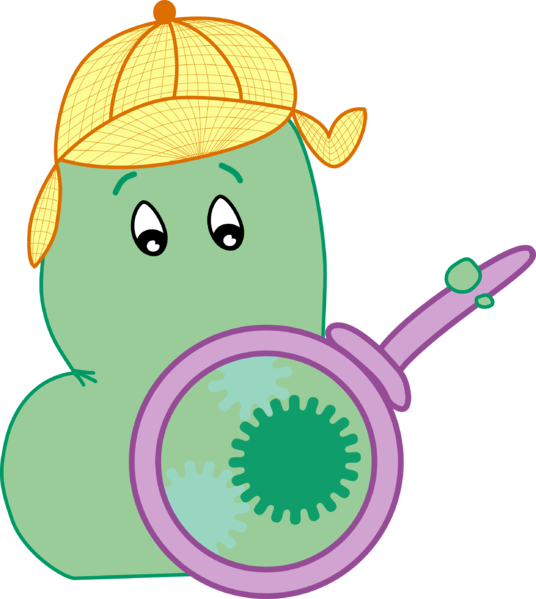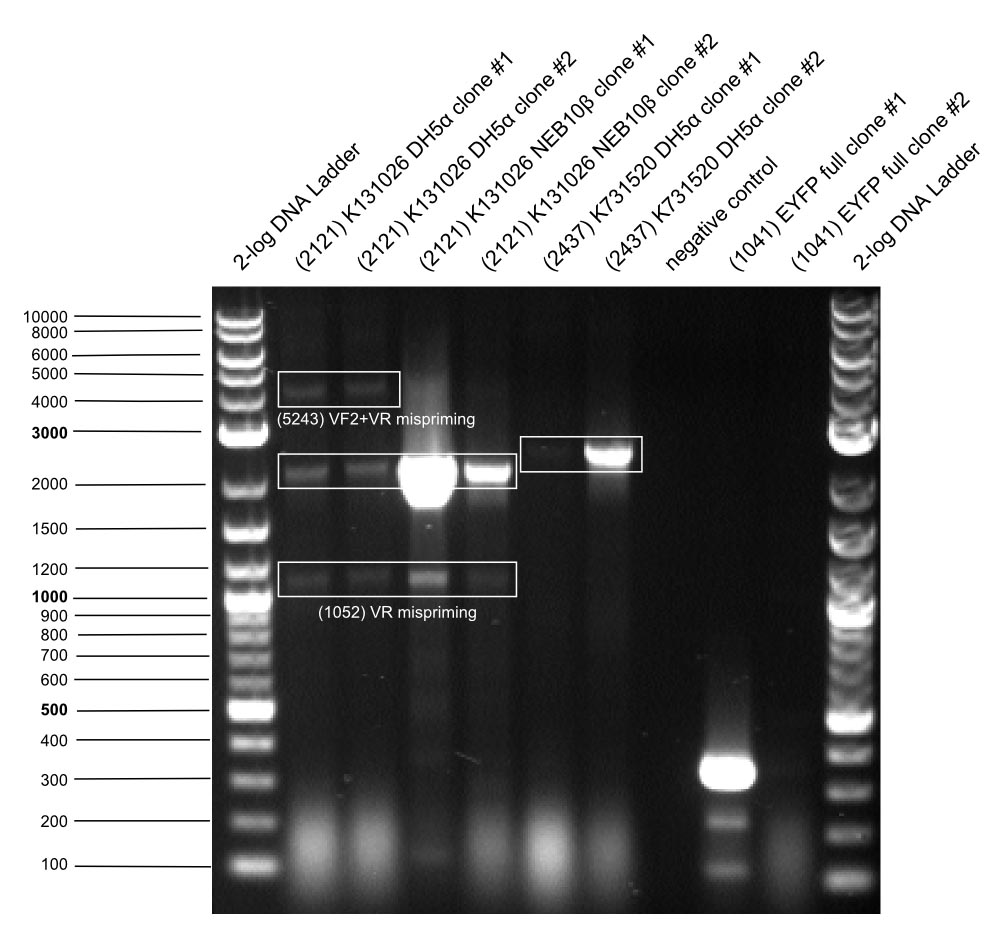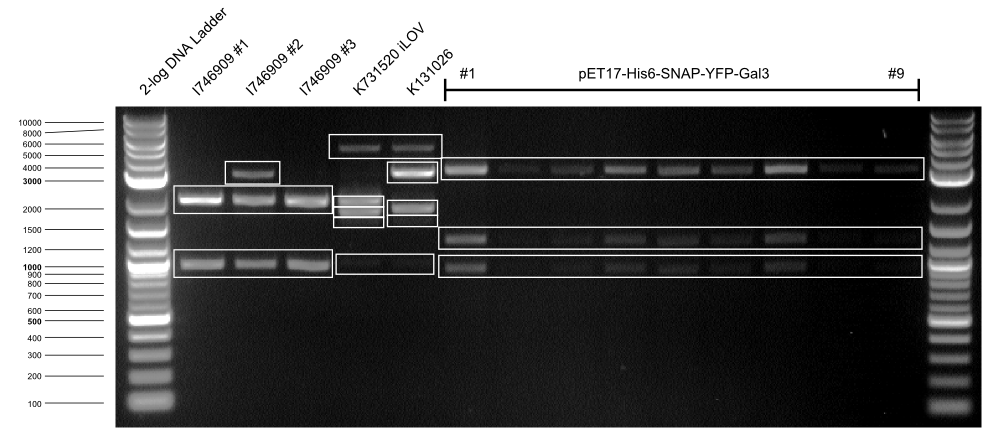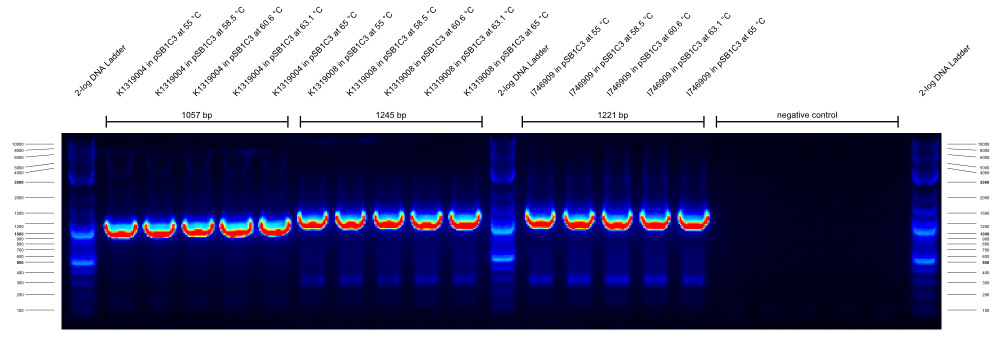|
|
|
|
|
| In order to detect the pathogens fast, specifically and inexpensively we are building sensor cells to detect these pathogens. These sensor cells can identify pathogens in very low concentration by responsing to specific extracellular molecules either secreted by or displayed on the pathogens. These molecules trigger a fast fluorescence response by our immobilized sensor cells which will be measured by our device.
| 
|
More information will be available soon!
May
8th
23rd
- Transformation some BioBricks
- Colony PCR (s. picture below)
June
25th
- prepared a preculture for competent NEB10β cells
- submitted samples for sequencing
- made master plates of transformed BioBricks
- centrifuged and froze overnight expression culture of J23101.E0240 and K516132
26th
- made competent NEB10β cells, however, several things went wrong. (For future reference: pre-cool centrifuge, always check if it's indeed spinning, frequently check OD of the culture)
- colony PCR on the transformed clones looked awful; there were too many cells in the 10 µL reaction volume. Some tubes were not fully sealed during the PCR. Basically only primers and smear, except for the positive control which contained a plasmid template instead of cells.
- 2x 500 mL of fresh LB and three sterile flasks were prepared and autoclaved.
July
16th
- did plasmid preps
- transformation of different reporter strains
- NEB
- pSEVE641_BsFbFP
- pSEVA234_LasR
- pSEVE641_BsFbFP pSEVA234_LasR
- pSEVE641_BsFbFP pSB1C3_C0179
- BL21
- pSEVE641_BsFbFP pSEVA234_LasR
- pSEVE641_BsFbFP pSB1C3_C0179
22nd
- Philipp and Michael made 100x stocks for Hartmans minimal medium.
- Michael and Vera made about 25 HM+C plates without glucose.
- K731520 iLOV was plated on a HM+C plate
23rd
- Michael made 25 new HM+C plates with 1 % agar and 4 g/L glucose
- He also added 170 µL of the glucose stock (500 g/L) to the glucose-free HM+C-plates
- 1 L of sterile HM+glucose was prepared
- K731520 iLOV was plated on HM+C+Glucose and HM+C+Glucose drops, 3x 5 mL HM+C+Glucose precultures were inoculated (17:00)
24th
- K731520 iLOV did not grow, neither on the plates, nor on in the liquid media. The most probable cause is that the E. coli is missing some vitamins
- Based on the [http://openwetware.org/wiki/M9_medium/supplemented M9 recipes by the Knight and Endy labs on OpenWetWare], we made a 20 mL supplement stock solution that can be added to 1x HM media
| Component | supplement for 1x HM [g/L] | final 1x concentration
|
| Casamino acids | 2 | 2 g/L
|
| Thiamine hydrochloride | 0.3 | 300 mg/L
|
| MgSO4/MgSO4*7H2O | 0.242 / 0.494 | 2 mmol/L
|
| CaCl2 | 0.011 | 0.1 mmol/L
|
The powders for 1 L of 1x HM were dissolved in 20 mL of a 10 % w/v Casamino acid stock solution and filter-sterilized (.22 µm PES). To make agar chips, we can add 1 mL to the hot agar mixture, together with the three 500 µL 100x stocks for the HM.
We made 250 mL of HM+C+Glucose+Supplements plates with 1.5 % agar.
Then we plated the following combinations:
| Construct | HM+C+Glucose+Supplements | LB+C
|
| K731520 iLOV | - | +
|
| J23101.E0240 | + | +
|
We also prepared a 150 mL HM+C+Glucose+Supplements culture with K731520 iLOV to hopefully make agar chips on Friday, July 25th.
6 of last weeks J23115.E0240 clones were plated on LB+C, and 5 mL LB+C precultures were inoculated for plasmid preparation.
25th
The K731520 iLOV strain did not grow on the HM plate, while another strain with the J23101.E0240 construct did. Both have the pSB1C3 backbone. To confirm the plasmids and inserts, Michael set up a colony PCR:
| ID | Template | Product Length | Result
|
| 1 | J23101.E0240 #5 | 1233 |
|
| 2 | J23101.E0240 #6 | 1233 |
|
| 3 | J23101.E0240 #5 plasmid | 1233 |
|
| 4 | K731520 iLOV LB colony | 2053 |
|
| 5 | K731520 iLOV plasmid | 2053 |
|
| 6 | K731520 GFP plasmid | 2437 |
|
| 7 | water | none |
|
Reaction volume per tube was 15 µL. GoTaq Green Mastermix and the VF2 and VR primers were used. You can find the durations and temperatures the table below:
| parameter | duration | temp [°C]
|
| denature | 10:00 | 95
|
| denature | 00:30 | 95
|
| anneal | 00:30 | 49
|
| elongate | 02:36 | 72
|
| elongate | 05:00 | 72
|
| store | forever | 8
|
Florian mini-prepped the 6 overnight cultures of J23115.E0240 clones. He used 3 mL instead of 1.5 mL culture medium and eluted twice with 25 µL nuclease-free water. Everything else was according to the protocol of the [http://www.gelifesciences.com/webapp/wcs/stores/servlet/productById/de/GELifeSciences/28904269 illustra plasmidPrep Mini-Spin Kit].
The resulting DNA concentrations are listed in this table:
| clone # | concentration [ng/µl]
|
| 1 | 73.5
|
| 2 | 94.5
|
| 3 | 100.5
|
| 4 | 53
|
| 5 | 82
|
| 6 | 138
|
In the evening, we plated some strains on the different media to investigate why the K731520 iLOV did not grow on the HM+suppl. plate. (Note: In the morning, Michael re-inoculated the HM+C+suppl. shake flask with cells from the LB-plate and by afternoon the culture did grow to a high cell density.)
| Construct | Host strain | LB+C | HM+C+Glucose | HM+C+Glucose+supplements
|
| J23101.E0240 | NEB10beta | ++ | - | ++
|
| K731520 iLOV | DH5alpha | ++ | - | (+)
|
| K131026 | NEB10beta | ++ | - | -
|
| K131026 | DH5alpha | ++ | - | +
|
Philipp inoculated J23101.E0240 in LB and HM+C+Glucose+supplements.
28th
29th
August
1st
- Stefan and Vera made electrocompetent E.coli cells.
- Arne prepared cultures of Renés iLOV and K131026 for Saturday, August 2nd.
2nd
- tested the OD measurement device and compared it to the spectrophotometer and the plate reader.
- tested K131026 and K731520 iLOV for fluorescence in the plate reader
- did a heat shock transformation of I746909 into NEB TOP 10 cells
- did an electroshock transformation of pET17-Gal3 into E.coli rosetta
3rd
- OD measurements of the iGEM device in comparison to the spectrophotometer were taken.
- cryo cultures of K131026 and K731520 iLOV were prepared
4th
- Arne and Michael made cryo stocks of K731520 iLOV and K131026 in NEB/BL21/DH5alpha, I746909 in BL21 and pET17-His-SNAP-YFP-Gal3 in E. coli rosetta (DE3), respectively.
- Michael did a plasmid prep, most of them using 1.5 mL culture medium, and eluted with 1x 50 µL of ddH2O. The resulting DNA concentrations are shown below.
| combination | concentration [ng/µl]
|
| I746909 BL21 #1 | 73.5
|
| I746909 BL21 #2 | 45
|
| I746909 BL21 #3 | 49
|
| K731520 iLOV DH5alpha | 60
|
| K131026 DH5alpha | 150
|
| pET17-Gal3 #1 | 30.5
|
| pET17-Gal3 #2 | 6.4
|
| pET17-Gal3 #3 | 6.3
|
| pET17-Gal3 #4 | 9.4
|
| pET17-Gal3 #5 | 10.1
|
| pET17-Gal3 #6 | 8.2
|
| pET17-Gal3 #7 | 13.8
|
| pET17-Gal3 #8 | 6.9
|
| pET17-Gal3 #9 | 10.2
|
To confirm the quality of pET17-Gal3 transformations, the purified plasmids were tested by carrying out a digest. Results are shown in the below picture and table.
| combination | cut products[bp]
|
| I746909 BL21 #1 | 2029, 947
|
| K731520 iLOV DH5alpha | 2029, 1780
|
| K131026 DH5alpha | 2029, 1848
|
| pET17-Gal3 #1 | 3086, 923, 1262
|
All pET17-Gal3 clones were positive and clone #1 was selected for further experiments.
5th
- Stefan, Arne and Michael assembled a VR=2.5 L bioreactor for cultivation of a 1 L expression culture.
- Two precultures of 20 mL LB+A were inoculated at 19:00
- Anna transformed K746909 into BL21 cells and K1319000 into NEB10beta cells.
6th
- Eshani and Arne transformed J04450 in pSB1K3 and pSB1A3 in NEB Beta cells.
- They also did a plasmid prep of J04450 in pSB1C3 and Flo's vectors.
- Arne made precultures of NEB Beta and DH5 alpha cells
- Arne and Michael inoculated the fermenter at 11:40, and induced the fermentation of pET17-Gal3. The fermentation is expected to run 24 h.
25th
- did a plasmid restriction of I20260 (EcoRI,PstI), J23115 (EcoRI, SpeI), K516032 (XbaI,PstI), and J23101 (EcoRI, SpeI).
26th
- ligation of J23115 and K516032 to J23115.K516032, and J23101 and K516032 to J23101.K516032, respectively.
- plasmid prep of I20260, K516032 and B0034
- restriction of plasmids I20260, K516032, B0034 with EcoRI and PstI
- A gel with restricted the I20260, K516032 and B0034 was run.
- purification of vector backbones pSB1A2, pSB3K3 and pSB1C3
- restriciton of synthesized TEV protease with EcoRI and PstI
27th
- ligation of J23101.K516032 into pSB3K3 and J23115.K516032 into pSB3K3 and K1319004 into pSB1C3
- transformation of K1319004 into pUC and pSB1C3, and J04450 into pSB1K3 and pSB1A3, respectively
September
3rd
Michael, Vera and Eshani prepared 50 mL LB+antibiotic overnight-cultures of pSBX-vectors that were sent in by team Heidelberg.
4th
- In the morning, at 10:15, Anna inoculated the precultures for the interlab study experiment.
- Michael prepared cryo stocks of the pSBX-carrying E. coli from the overnight cultures. He also purified each pSBX-vector, eluting with 15+30 µL water, and resulting in the following DNA concentrations:
| vector | concentration [ng/µL]
|
| pSBX1A3 | 111
|
| pSBX4A5 | 14.1
|
| pSBX1C3 | 31
|
| pSB4C5 | 98.5
|
| pSBX1K3 | 18
|
| pSBX4K5 | 30
|
| pSBX1T3 | 39
|
| constitutive expression plasmid | 73
|
- Anna did PCRs for Gibson assembly of K1319003 into pET17. Duplicates of 25 µL reaction volume (12.5 µL Q5 2x Master Mix, 1.25 µL per primer, 2 µL template)
| PCR tube # | components
|
| 1 and 2 | pET17 + pET17_Gal3_Gib_F + pET17_Gal3_Gib_R
|
| 3 and 4 | K1319003 + K1319003_Gib_F + K1319003_Gib_R
|
The PCR conditions:
| step | temperature [°C] | duration
|
| denature | 98 | 30", 98 °C for 10", 55 °C for 30", 72 °C for 2'15"
|
| denature | 98 | 10"
|
| anneal | 50 (insert) 55 (backbone) | 30"
|
| elongate | 72 | 0'30" (insert) 2'15" (backbone)
|
| elongate | 72 | 2"
|
| store | 8 | indefinite
|
Finally, Florian did the Gibson assembly and a heat shock transformation into NEB10beta cells.
At 10:15, Arne inoculated the primary cultures of the interlab study experiment and began with regular fluorescence measurements.
5th
- Anna made master plates of yesterday's transformed cells.
6th
- Anna made precultures of 3 clones from each prepared master palte and inoculated precultures for OD/F measurements as well as chip production on the 7th.
7th
- Anna made cryos stocks of the precultures.
- Michael and Arne purified the following plasmids:
| plasmid | strain | resistance | vector | # of clone picked | concentration [ng/µl]
|
| K1319000 in I20260 | NEB10ß | K | pSB3K3 | 1 |
|
| K1319000 in I20260 | NEB10ß | K | pSB3K3 | 3 |
|
| K1319000 in I20260 | NEB10ß | K | pSB3K3 | 5 |
|
| K1319001 in I20260 | NEB10ß | K | pSB3K3 | 1 |
|
| K1319001 in I20260 | NEB10ß | K | pSB3K3 | 5 |
|
| K1319001 in I20260 | NEB10ß | K | pSB3K3 | 6 |
|
| K1319002 in I20260 | NEB10ß | K | pSB3K3 | 1 |
|
| K1319002 in I20260 | NEB10ß | K | pSB3K3 | 5 |
|
| K1319002 in I20260 | NEB10ß | K | pSB3K3 | 6 |
|
| K1319001_GFP Fusion in I20260 | NEB10ß | K | pSB3K3 | 4 |
|
| K1319001_GFP Fusion in I20260 | NEB10ß | K | pSB3K3 | 5 |
|
| K1319001_GFP Fusion in I20260 | NEB10ß | K | pSB3K3 | 6 |
|
| K1319002_GFP Fusion in I20260 | NEB10ß | K | pSB3K3 | 3 |
|
| K1319002_GFP Fusion in I20260 | NEB10ß | K | pSB3K3 | 4 |
|
| K1319002_GFP Fusion in I20260 | NEB10ß | K | pSB3K3 | 5 |
|
| His-SNAP-YFP-K1319003 | NEB10ß | A | pET17 | 3 |
|
| His-SNAP-YFP-K1319003 | NEB10ß | A | pET17 | 4 |
|
| His-SNAP-YFP-K1319003 | NEB10ß | A | pET17 | 6 |
|
Elution was performed with 2 * 15 µL of nuclease free water.
15th
Arne and Michael were able to analyze the sequencing data from the clones of GFP_Reach 1, GFP_Reach 2 and K1319008.
GFP_Reach 2 clone #3 and #5 were fine, including the Leu to Ile mutation.
GFP_Reach 1 clone #4 and #5 were fine and did not contain the Leu to Ile mutation. Clone #6 was fine but contained the Leu to Ile mutation from the Reach 1 quick change mutations.
For future experiments, we will use the GFP_Reach 1 clone #4 and the GFP_Reach 2 clone #4.
Transformation of GFP_Reach 1 clone #3 and GFP_Reach 2 clones #3 and #5 were performed together with the TEV protease to create two plasmid construct.
The GFP_Reach 1 and GFP_Reach 2 constructs were also restricted and ligated into the pSB1C3 vector from the pSB3K3 vector.
16th
Vera made master plates for the transformation from the day before.
Also PCRs were made from pSBXA3, I20260 and K131900 for a Gibson Assembly. The PCRs were checked with a gel electrophoresis.
17th
18th
19th
Rene, Arne and Philipp made cultures of K1319013, K1319013 + K1319008, K1319013 + K1319008 + iPTG, K1319014, K1319014 + K1319008, K1319014 + K1319008 + iPTG, B0015 (negatove control) and I20260 (positive control).
iPTG was added at an OD of ~0,5.
Inoculation was done via precultures in 500 ml shake flasks (50 ml filling volume). Media was always LB. Cultivation was done at 37 degrees Celsius and 300 rpm.
Starting OD was aimed to be 0,1. Inoculation occured directly from the precultures.
Samples will be taken every hour and checked for OD and fluorescence (Spektrometer and Platereader respectively).
Vera did a pasmid preparation from the cultures of the day before which were K1319013, K1319013 + K1319008, K1319013 + K1319008 + iPTG, K1319014, K1319014 + K1319008, K1319014 + K1319008 + iPTG, B0015 (negatove control) and I20260 (positive control).
The plasmid will then be cut with EcoRI and PstI and the results will be put on an agarose gel in order to perform a restriction test.
Also plasmids of K1319013 and K1319014 will be cut with EcoRi and SpeI. K1319008 will be cut with XbaI and PstI. These will then be ligated together and then ligated into a pSB1A3 vector via the 3A assembly (vector cut with EcoRI and PstI).
These constructs will be transformed into BL21 (and NEB as a backup). The created construts will be known as K1319018 (K1319013.K1319008) and K1319019 (K1319014.K1319008).
Florian made precultures of the master plates from the day before (K1319008, K1319013, K1319015 and pSBX1A3 with Gal3).
Arne also inoculated 4 cultures for the further testing of the OD/F device (the F part). The cultures are 2 shake flasks of I20260 and 2 shake flasks of B0015.
Furthermore Nina did a growth experiment with DH5alpha for the Neanderlab school experiment. It is done at 37 degrees Celsius and 300 rpm in TB Media. It was inoculated for an OD of 1,5. Samples are taken every 30 minutes and tested for OD (Spektrometer).
Anna also made chips with K1319013 + K1319008, K1319014 + K1319008, K1319013, K1319014, B0015 and K131026.
These will be inocubated for an hour at 37 degress Celsius. Then they will be induced with iPTG/HSL and fotos will be made every 30 minutes to check for fluorescence (GFP).
Florian tested our OD/F device with a dilution test. Samples were checked with Spektrometer (OD) our OD/F device (fluorescence) and platereader (fluorescence).
Anna and Vera made SDS Gels.
Stefan inoculated a culture of K1319008, B0015 as well as I20260 to check wether the results from our construct are from a wrongly done Gibson Assembly with a still functioning superfolder GFP.
20th
26th
- Michael did a check PCR on several cryo cultures. All samples with G00100_Alternative+K1319004_check_R combinations resulted in a strong band at ~2300 bp that we cannot explain. All G00100_Alternative+K1319004_check_R combinations resulted in a strong band at 900 bp that we cannot explain either. We concluded that the annealing temperatures were wrong and favored unspecific products. Therefore we decided to do a gradient PCR to find out the optimal annealing temperatures for our new primers.
Gradient PCR to test new primers
Florian and Michael did gradient PCR with these new primers:
| name | sequence
|
| G00100_Alternative | GTGCCACCTGACGTCTAAGAAACCATTATTATC
|
| G00101_Alternative | ATTACCGCCTTTGAGTGAGCTGATACCGCTCG
|
| K1319004_check_R | ACGGAATTTCAGTTTCTGCGGGAACGGCGG
|
| I746909_check_R | ATCTTTAGACAGAACGCTTTGCGTGCTCAG
|
Three PCRs with different primer combinations were run. In all of them the templates were K1319004 in pSB1C3, K1319008 in pSB1C3 and I746909 in pSB1C3.
The first gradient PCR tested the G00100_Alternative + G00101_Alternative combination:
| primer_F | primer_R | template | expected length | best annealing temperature
|
| G00100_Alternative | G00101_Alternative | K1319004 in pSB1C3 | 1057 | ???
|
| G00100_Alternative | G00101_Alternative | K1319008 in pSB1C3 | 1245 | ???
|
| G00100_Alternative | G00101_Alternative | I746909 in pSB1C3 | 1221 | ???
|
| G00100_Alternative | G00101_Alternative | water | --- | ???
|
The second gradient PCR tested the G00100_Alternative + I746916_check_R combination:
| primer_F | primer_R | template | expected length | best annealing temperature
|
| G00100_Alternative | I746916_check_R | K1319004 in pSB1C3 | none | ???
|
| G00100_Alternative | I746916_check_R | K1319008 in pSB1C3 | none | ???
|
| G00100_Alternative | I746916_check_R | I746909 in pSB1C3 | 820 | ???
|
| G00100_Alternative | I746916_check_R | water | --- | ???
|
The third gradient PCR tested the G00100_Alternative + K1319004_check_R combination:
| primer_F | primer_R | template | expected length | best annealing temperature
|
| G00100_Alternative | K1319004_check_R | K1319004 in pSB1C3 | 541 | ???
|
| G00100_Alternative | K1319004_check_R | K1319008 in pSB1C3 | 502 | ???
|
| G00100_Alternative | K1319004_check_R | I746909 in pSB1C3 | none | ???
|
| G00100_Alternative | K1319004_check_R | water | --- | ???
|
The results of these three PCRs are:
- The KAPA2G Fast ReadyMix worked well
- all three primers work well at >65 °C annealing temperature
- the K1319008 template was contained I746916 instead of the intended K1319004 ORF
It was concluded that a similar check PCR with 65 °C annealing temperature will be done on all plasmids and cryos of K1319008.
27th
First Michael transformed K1319001, K1319002, K1319003 and K1319004 (all in pSB1C3) into NEB10beta cells. He tested the PCR machine for semi-automated heat-shocking by splitting the 50 µl cells with the plasmid into 2x 25 µl. All 100 µl were plated for all construct/machine combinations.
Vera transformed several constructs into chemically competent BL21(DE3) cells.
Philipp and Michael did colonyPCR on all plasmids, cryos and colonies that should contain the K1319004 sequence.
Vera also made check a PCR on galectin-constructs:
| label | primer_F | primer_R | expected length | result
|
| Gal3 in pSBX1A3 #1 | G00100_Alternative | K1319003_R | 1684 | ???
|
| Gal3 in pSBX1A3 #2 | G00100_Alternative | K1319003_R | 1684 | ???
|
| Gal3 in pSBX1A3 #3 | G00100_Alternative | K1319003_R | 1684 | ???
|
| Gal3 YFP #3 | pETGal3_seq_F | K1319003_R | 867 | ???
|
| Gal3 YFP #3 | pETGal3_seq_F | K1319003_R | 867 | ???
|
| Gal3 YFP pet17 AmpR | pETGal3_seq_F | K1319003_R | 867 or none | ???
|
| pET17 Gal3 #1 | pETGal3_seq_F | K1319003_R | none | ???
|
| K1319003 in pSB1C3 | G00100_Alternative | K1319003_R | 930 | ???
|
28th
Michael made a restriction of BioBrick K1319020 and vector pSB1C3 with restriction enzymes EcoRI and PstI. Then Vera ligated the rescrikted parts and made a transformation using E. coli NEB 10ß cells.
29th
Eshani made cryo cultures and plasmid preparation of K1319010, K1319011, K1319012, K1319021 and K1319042. Vera determined the contentration of plasmids and made restriction of K1319010, K1319011, K1319012, pSB1C3, K1319021, K1319013 and K1319014 with following ligation in K1319010.pSB1C3, K1319011.pSB1C3, K1319012.pSB1C3, K1319021.K1319013.pSB1A3 and K1319021.K1319013.pSB1A3. All constracts were transformed into E. coli NEB 10ß.
30th
Sequencing samples were sent in for K1319020 clone #2, 3 & 5 (in pSB1C3), K1319017 clone #1 (in pSB1C3), K1319010 clone #2 (in pSB3K3), K1319011 clone #1 (in pSB3K3), K1319012 clone #2 (in pSB3K3), K1319013 clone #1 (in pSB1C3), K1319014 clone #1 (in pSB1C3), K1319001 (in pSB1C3) and K1319002 (in pSB1C3).
A plasmid prep of K1319013 and K1319014 was run.
A Gibson Assembly with the subsequent transformation for K1319015 from the I20260 backbone and the K1319000 insert was conducted.
pSB1C3 plasmid backbones were amplified via PCR and purified.
Colony PCRs of K1319008 and K1319012 master plates were made for confirmation. Pre-cultures were inoculated subsequently.
A transformation of K1319010 and K1319010 in pSB1C3 was conducted.
Another plasmid prep of K1319010 clone #2, K1319011 clone #1, K1319012 clone #2 (all in pSB3K3), K1319013 clone #4, K1319014 #3, K139020 #2, 3, 5 (all in pSB1C3) was run.
The OD device was tested with a dilution series of a Pseudomonas putida culture.
October
1st
2nd
- At 8:30, Nina and [User:AZimmermann|Arne]] did a plasmid prep of dublicate samples of K1319011 clone #1 and #6. [User:fgohr|Florian] measured the DNA yield, and the higher concentrated sample of clone #1 and #6, respectively, were sent in for sequencing.
- Nina made precultures and a master plate of 6 colonies of K3139008 in psB1C3 in NEB10beta cells that had been plated at 5:30 this morning.
|
 "
"





